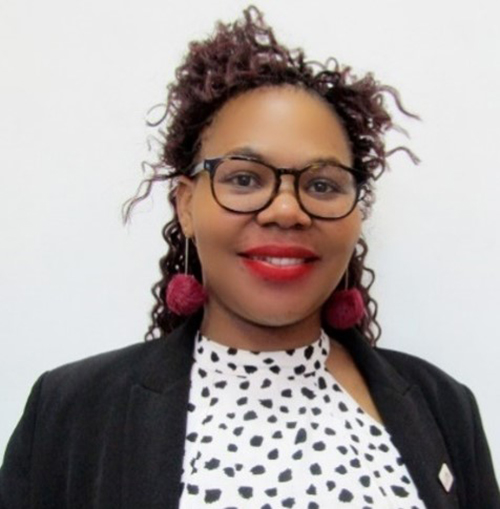
As we have recently come out of the Youth Month, we continue to shine a light on young and outstanding researchers who continue to break new ground and achieve excellence in their lines of work. In the spotlight is Dr Usisipho Feleni, a senior lecturer at the Institute for Nanotechnology and Water Sustainability (iNanoWS) at the College of Science, Engineering and Technology. Dr Feleni was recently awarded an NRF-SAASTA Engaged scholarship grant of R500 000 and we chatted to her to learn more about her recent win.
Background of the grant
The grant was awarded for the development of exhibits at the Cofimvaba Science Centre in the Intsika Yethu Local Municipality, Eastern Cape. The science centre serves as a platform for the introduction of innovative technologies to improve the quality of learning and teaching in the Cofimvaba School district in the Eastern Cape. Technologies that have been tested in other contexts may also be introduced through this platform.

Dr Feleni
The science centre is intended to advance the DSI's efforts to promote public awareness of and engagement with science. By getting learners excited about science, engineering and technology (SET), the centre will encourage young people to take Mathematics, Science and Technology (MST) at school and to follow careers in these fields. In this way, it will also contribute to the development of the skilled workforce that South Africa needs. The four focus areas of the centre will be science engagement, curriculum support for MST, SET career education, and talent nurturing. The centre will accommodate up to 50 000 visitors per annum in school groups.
The sections of society being targeted for participation are learners, educators, science interpreters, journalists, the general public, decision-makers, students, industry, tourists, indigenous knowledge holders, researchers and scientists.
Awarding body
Dr Feleni’s grant was awarded by the National Research Foundation’s South African Agency for Science and Technology Advancement (NRF-SAASTA).
“The South African Agency for Science and Technology Advancement (SAASTA), a business unit of the National Research Foundation (NRF) is mandated to advance public awareness, appreciation and engagement of science, technology, engineering, mathematics and innovation (STEMI) in South Africa.”
Applying for the grant
We asked Dr Feleni what had motivated her to apply for the grant. She replied that she was born in a very small village called Ndungwana in the Eastern Cape Province and that it was there that she completed her primary level schooling at Khanyisa Junior Secondary School. After primary school, she went on to complete her high school education at St James Senior Secondary School in Cofimvaba. “During my studies,” she added, “I was facing a lot of challenges in selecting my career path because there were no science centre exhibits and role models coming from the Eastern Cape who would provide some guidance in career selection.”
The impact and relevance of research
According to Dr Feleni, she was raised with the knowledge that being a leader also means being the greatest servant. this, she says, nurtured in her a passion to make a positive and meaningful difference in society through the identification of African problems and by using African solutions to solve them. Her professional goals, she says, “are to utilise [her] knowledge and leadership skills to encourage and promote innovative ideas to advance medical diagnostics and affordable energy.” This meant, she added, that she would be able to make a difference in her community and in her country.
Dr Feleni applied for the grant because of the Cofimvaba Science Centre’s plans to host a comprehensive science, engineering and technology career awareness programme that will help guide the career choices of learners. Playing a significant part of the science engagement landscape by having interactive and hands-on exhibits and related programmes, the centre will provide a platform for society to engage with Science Engineering and Technology (SET), thereby addressing the four strategic goals of science centres. According to Dr Feleni, the strategic goals for this programme include firstly, promoting science awareness among the youth and general public, secondly, identifying and nurturing talent and potential, thirdly providing mathematics, science and technology support, and finally, providing SET career education. It was these goals, she says, that “attracted me to applying for this call for funding to make a difference and give back to my hometown community and to act as a role model to a younger generation.”
The funding will also assist learners, students and researchers to start building their foundation from secondary school and undergraduate studies level, as well as to work hard and aspire to do very well in their academic work. “It will,” she says, “motivate students to also do their MSc and PhD projects in areas that have both national and international interest and lead to solutions in such important areas that address important societal challenges such as climate change, food security, environmental sustainability and health issues.”
What the grant will be used for?
The grant will be used in showcasing the nanotechnology applications for environmental electrochemical based protocols for medical (e.g., testing for diabetes, HIV, SARS-Cov-2, TB and other diseases) and water analysis, as well as for cost-effective energy storage material development. Another important point is that the grant will, in addition, be used in developing curricula and for training in physical chemistry and integrated chemistry for learners in grades 8 to 12.
Dr Feleni is currently a thematic area leader for Applied Electrochemistry at iNanoWS and she is involved in the supervision of four master’s students, two doctoral students and has undertaken the co-mentorship of two postdoctoral fellows.
*Compiled By: Dr Nozipho Gumbi, Acting Communication and Marketing Specialist, College of Science, Engineering and Technology and Dr Usisipho Feleni, Senior Lecturer, Institute for Nanotechnology and Water Sustainability (iNanoWS)
Publish date: 2021/07/01